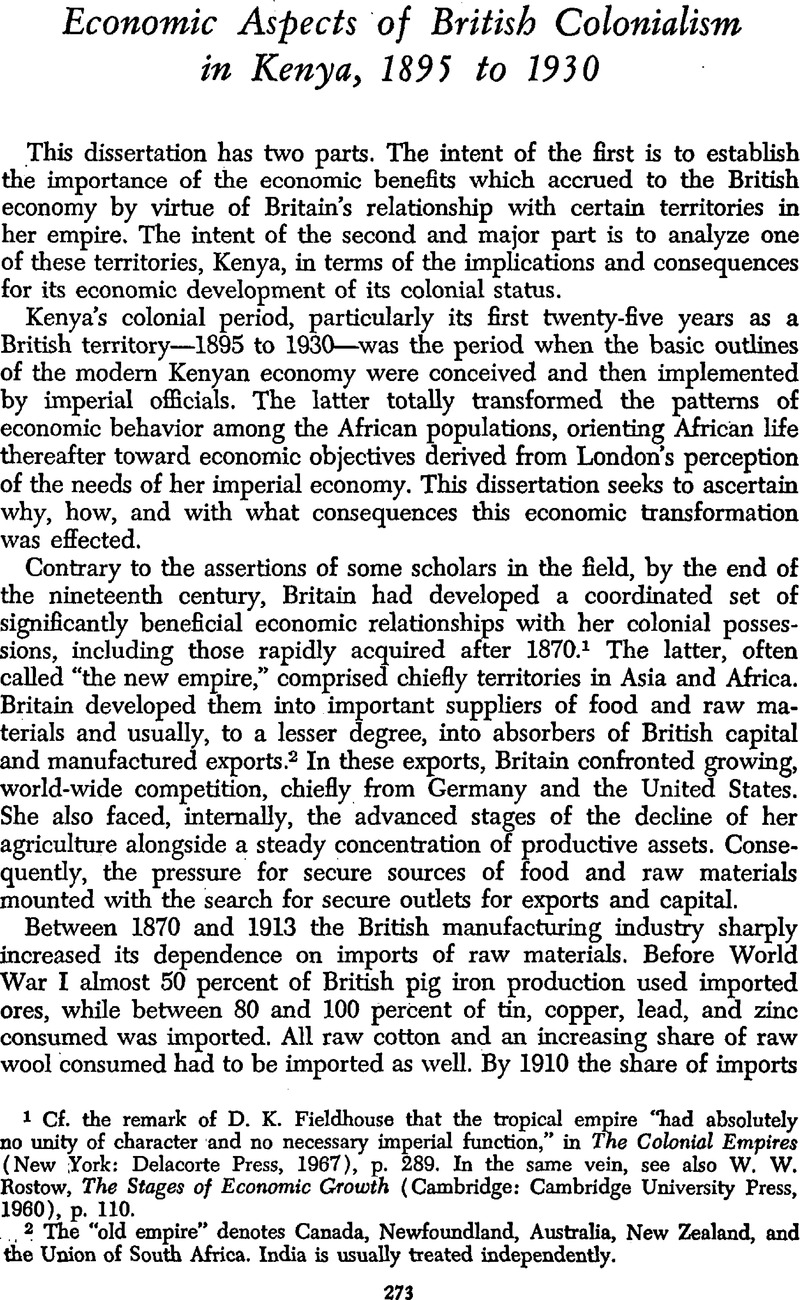Article contents
Economic Aspects of British Colonialism in Kenya, 1895 to 1930
Published online by Cambridge University Press: 03 February 2011
Abstract

- Type
- Summaries of Doctoral Dissertations
- Information
- Copyright
- Copyright © The Economic History Association 1970
References
1 Cf. the remark of Fieldhouse, D. K. that the tropical empire “had absolutely no unity of character and no necessary imperial function,” in The Colonial Empires (New York: Delacorte Press, 1967), p. 289Google Scholar. In the same vein, see also Rostow, W. W., The Stages of Economic Growth (Cambridge: Cambridge University Press, 1960), p. 110.Google Scholar
2 The “old empire” denotes Canada, Newfoundland, Australia, New Zealand, and the Union of South Africa. India is usually treated independently.
3 Hall, A. D., Agriculture After the War (London: J. Murray, 1916), p. 12Google Scholar, and Page, W., Commerce and Industry, II (London: Constable and Co., Ltd., 1919), 200–2.Google Scholar
4 See Schlote, W., British Overseas Trade from 1700 to the 1930's, translated by Henderson, W. O. and Chaloner, W. H. (Oxford: Basil Blackwell, 1952), pp. 164–5.Google Scholar
5 Cf. Lawrence, J. C., The World's Struggle With Rubber, 1905–1931 (New York: Harper and Brothers, 1931), pp. 12 ff.Google Scholar
6 Hobson, J. A., Imperialism: A Study, revised ed. (London: George Allen and Unwin, Ltd., 1905), pp. 36–40Google Scholar. For a recent reaffirmation, see Fieldhouse, , “Imperialism: An Historiographical Revision,” Economic History Review, second series, XIV, No. 2 (1961), p. 203.Google Scholar
7 Hoffmann, W. G., British Industry, 1700–1950, translated by Henderson, W. O. and Chaloner, W. H. (Oxford: Basil Blackwell, 1955), p. 83.Google Scholar
8 Paish, G., “The Export of Capital and the Cost of Living,” The Statist. February 14, 1914, p. v.Google Scholar
9 The dissertation devotes some brief discussion to efforts in this direction.
10 This dissertation does not seek to reach conclusions on the related but different questions of whether, in some sense, colonies returned more than they cost the colonizers, or whether Britain might conceivably have developed similar economic ties with these territories had they not been her colonies.
11 The East Africa Protectorate was renamed the Protectorate and Colony of Kenya in 1920.
12 Cf. Robinson, R., Gallagher, J., and Denny, A., Africa and the Victorians (New York: St. Martin's Press, 1961), where this argument is broadly elaborated.Google Scholar
13 Completed in 1902, the capital for this major investment project was raised in London under a Treasury guarantee of interest payments.
14 The share of total domestic exports provided by these three staples rose from 47 percent in 1920 to 72 percent in 1930; cf. Report of the Commission on the Financial Position and System of Taxation in Kenya, Colonial No. 116, London, 1936, p. 8 and Appendix II, pp. 254–5.Google Scholar
15 Sleith, T., Report on Trade Conditions in British East Africa, Uganda and Zanzibar (Cape Town, South Africa: Department of Lands and Mines, 1919)Google Scholar. It is not without significance that a South African made this observation.
16 Three studies have found that European agriculture in Kenya during the 1920's was generally precariously based, artificially protected, and, in strict accounting terms, an inefficient use of resources. See Frankel, S. H., Capital Investment in Africa (London: Oxford Univ. Press, 1938), p. 269;Google ScholarSchott, J. R., The European Community of Kenya, Harvard Ph.D. Dissertation, 1964, pp. 86 ff;Google Scholar and Wrigley, C. C., “Kenya, The Pattern of Economic Life, 1902–1945,” in Harlow, V., Chilver, E. M., and Smith, A., eds., History of East Africa, 2, (Oxford: Clarendon Press, 1966), pp. 209–64.Google Scholar
- 4
- Cited by




